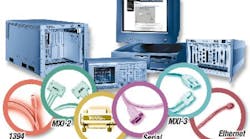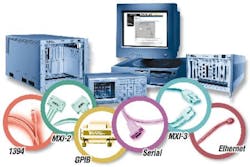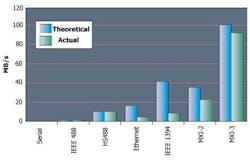Virtual instrumentation continues to benefit from new technologies that speed the link between PCs and instruments. IEEE 488 (GPIB), IEEE 1394 (FireWire™), and MXI-2 offer increasing levels of performance for remotely controlling box instruments and VXI systems. Ethernet is used increasingly more as a low-cost, remote-control technology for a variety of instrumentation devices.
Many factors affect the selection of an instrumentation platform and whether a remote or embedded control scheme is used. These considerations include performance, software demands, ease of integration, and price. When choosing remote-controller technology, factors such as cable flexibility, interconnect length, and link bandwidth are important. Ultimately, a careful analysis of an application’s specific needs will clarify the choice of a platform and a control scheme.
Remote vs Embedded Control
Embedded control of instrumentation has a very long history since the earliest electronic instruments were single, stand-alone devices with integrated controls, displays, and measurement hardware. The advance of digital technology further defined the concept of an embedded controller since microprocessors running embedded operating systems could be used to manage an instrument’s functionality. In the early 1980s, the concept of virtual instrumentation introduced a way to control instruments—remotely from a PC via an IEEE 488 bus interface.
Today, most automatic test and measurement applications use the power of the PC as the central component of the test system. Desktop PCs bring exceptional processing power to test applications at a very low cost.
In turn, PC technology has become the basis of embedded-controller technology used for stand-alone box instruments as well as modular instrumentation systems such as VXI and PXI™/CompactPCI. PC technology also has a strong influence on the methods used to remotely control instrumentation. Although IEEE 488 still is the predominant link for instrumentation today, PC-based link technologies such as IEEE 1394, RS-232, and Ethernet have become part of the remote-control palette for instrumentation.
The need to make a choice between remote or embedded control is most evident to users of modular instrumentation systems. With VXI, the end user decides whether to use a standard desktop PC with an IEEE 488, MXI-2, or IEEE 1394 link to the VXI chassis or a self-contained embedded controller.
Typically, an embedded controller is the highest performance option, but it also comes at the highest price. Remote-control links are less expensive because they leverage off the low prices of PCs. Until now, PXI modular instrumentation could only be powered with an embedded controller. Now, MXI-3 brings remote-control capability to the PC-based PXI/CompactPCI architecture.
Remote-Control Architectures
IEEE 488 and HS488
At the heart of virtual instrumentation is the link between standard PCs and instrumentation equipment. IEEE 488 was the first link between PCs and instruments that ushered in the virtual instrumentation age in the early 1980s. IEEE 488 allowed PC users to control box instruments with PC software used for acquisition, analysis, and presentation of data.
IEEE 488 still is very widely used today, but its typical bandwidth of 1 MB/s drove the development of faster links. High-speed 488 (HS488), built on the standard IEEE 488 architecture, offers an improvement to 8 MB/s for connections to box instruments.
Multisystem Extension Interfaces
The VXI architecture introduced in 1988 defined a modular instrumentation architecture where multiple instrument modules fit into a single standardized mainframe or chassis. With VXI came the introduction of a technology called the Multisystem Extension Interface (MXI) that linked PCs to modular instrumentation at rates more than 20 times faster than the original IEEE 488 link. Because of its high performance and seamless operation for multi-mainframe expansion, MXI-2 has surpassed IEEE 488 as the most popular PC-to-VXI interface today.
In 1997, the introduction of PXI lowered the cost and reduced the size of modular instrumentation. The PXI specification, governed by the PXI Systems Alliance (www.pxisa.org), expanded the CompactPCI specification by adding more rigid system-level specifications.
PXI defines more rigid standards for chassis/controller configuration to promote multivendor interoperability. It also adds environmental specifications to ensure reliable operation and new features expressly for instrumentation applications such as backplane timing and triggering. Although PXI promises faster, smaller test systems, test developers only had one option for controlling PXI systems—the embedded computer.
PXI systems with embedded computers typically are more expensive than desktop PCs, and embedded computer technology often lags the PC industry because of more stringent space limitations. MXI-3 eliminates the dependence on an embedded computer, allowing test developers to build PXI/CompactPCI systems that fully harness the power of the newest PCs (see sidebar).
PC Links: Serial, Ethernet, and IEEE 1394
In addition to IEEE 488, serial links to instrumentation using RS-232 have been used for many years and still are very common. The proliferation of RS-232 interfaces on instruments is the direct result of serial ports being on practically every PC built during the past two decades. Ethernet, the standard way to network multiple PCs, now is becoming almost as common as serial ports on PCs. As a result, more and more instrumentation systems use Ethernet as the primary communications interface.
VXI and PXI embedded controllers come with integrated Ethernet ports for communicating with PCs. Remote data acquisition software gives PCs direct control of measurement devices in PXI/CompactPCI systems via the Ethernet port on the PXI embedded controller. Ethernet also is making inroads into box instrument architectures where direct networking with PCs has become a requirement.
IEEE 1394 is an emerging PC link technology that has yet to see the same proliferation as RS-232 and Ethernet. However, IEEE 1394 controllers for VXI already are available as inexpensive remote-control solutions.
Choosing the Right Remote-Control Solution
When using a PC to control a test system, several factors must be considered before choosing an appropriate link technology. Performance, cable characteristics, software demands, ease of integration, distance, and cost vary widely from one technology to the other. Naturally, the availability of a particular link technology for a given instrumentation architecture is the first consideration. However, the choice of link technology often can drive the decision of which instrumentation architecture to use (Figure 1).
Performance
Generally, box instruments only are available with serial, IEEE 488, or HS488 links. Some new instruments are controlled via Ethernet. VXI and PXI systems with Ethernet ports on their embedded controllers can be networked with PCs for low-speed connections.
For true remote control, VXI modular instrumentation systems take advantage of the high bandwidth connection of MXI-2 or use lower-cost IEEE 488 or IEEE 1394 connections. For remote control of PXI/CompactPCI modular instrumentation, MXI-3 delivers the fastest performance of any instrumentation link architecture.
Figure 2 shows the maximum theoretical and actual block performance realized by the most popular PC-to-test-system configurations. Some architectures such as IEEE 1394 boast very high theoretical performance but fall short on actual performance.
Figure 2
MXI-3 achieves its performance advantages by exploiting the PCI bus and advancing the concept of PCI-to-PCI bridging to remote system control rather than the conventional implementation for slot expansion on a PC motherboard. By transparently bridging the PCI bus in your PC to the PCI bus in a PXI/CompactPCI system, MXI-3 delivers seamless expansion while achieving greater than 90 MB/s actual block throughput rates.
Cable Size and Length
Besides performance, other factors can affect the choice of remote-control technology. Cable characteristics such as flexibility often are very important to the system designer who must route cables through tight spaces. IEEE 1394, Ethernet, and MXI-3 all use very flexible cables with small connectors while IEEE 488 and MXI-2 require larger, more bulky cabling (Figure 1).
Many applications only require short interconnect distances (less than 5 meters) which practically all technologies can span. For direct, long-distance connections more than 100 meters, the choices are limited to Ethernet for low bandwidth and MXI-3 for the highest bandwidth. Indirect connections that use converters to achieve long distance are available for IEEE 488 and serial.
Cost
Cost ultimately depends on the proliferation of a particular technology. As a result, PC-based technologies have a cost advantage because of the tremendous volumes generated by the PC industry. Ethernet and serial interfaces are less expensive than IEEE 1394 and MXI interfaces because they are a more common component of standard PCs. However, the test-system developer must consider the overall cost affected by the integration and development time and the system performance that affects test throughput.
Ease of Integration and Software
The ease of integration of a remote link depends greatly on the software. MXI-2 and IEEE 488 require software; however, the performance does not dramatically suffer since the hardware links were developed specifically for instrumentation extension. More general-purpose links such as Ethernet and IEEE 1394 sustain significant losses in performance due to the software overhead required for implementing remote control of instrumentation (Figure 2). MXI-3 offers the most simple and straightforward integration because it is a fully transparent link that does not require any software.
For test and measurement, MXI-3 gives PCs direct control of PXI/CompactPCI systems via a software-transparent link with speeds approaching 100 MB/s over distances up to 200 meters without repeaters. MXI-3 complies with standard PCI-to-PCI bridging specifications and uses 1.5 Gbit/s serial technology to establish a transparent software and hardware link between PCI computers and PXI/CompactPCI systems. Once MXI-3 hardware is installed, the host computer automatically initiates communications with all connected chassis, and the entire multichassis system operates as if it were a single PC.
Every MXI-3 link consists of a primary and a secondary MXI-3 card and a single copper or fiber-optic cable connecting the two cards. With MXI-3, a variety of system configurations is possible. From standard PCI computers, you can interface to PXI/CompactPCI systems as well as control multiple systems in a star or daisy-chain configuration. Using a PXI-to-PXI kit configuration, you can develop multichassis applications and control the entire system from a single PC or PXI embedded controller.About the Author
Carsten Puls is thePXI/CompactPCI product marketing manager at National Instruments and chairman of the PXI Systems Alliance. Mr. Puls, who joined National Instruments in 1995, also is an executive-level member of the PCI Industrial Computer Manufacturers Group. He holds a B.S. in mechanical engineering from Louisiana State University and an M.S. in engineering from the University of Texas/Austin. National Instruments, 11500 N. Mopac Expressway, Austin, TX 78759, (512) 794-0100.
Return to PC-Based Test Online – Return to EE Home Page
Published by EE-Evaluation Engineering
All contents © 1999 Nelson Publishing Inc.
No reprint, distribution, or reuse in any medium is permitted
without the express written consent of the publisher.
August 1999


